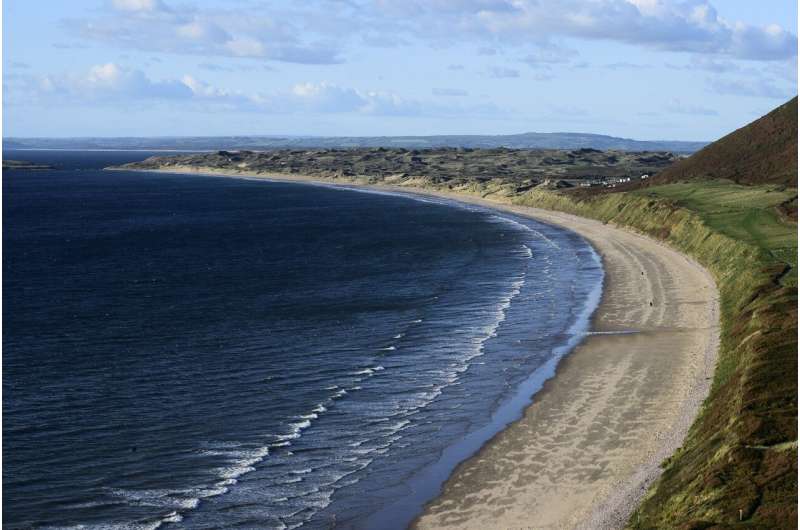This article has been reviewed according to Science X's editorial process and policies. Editors have highlighted the following attributes while ensuring the content's credibility:
fact-checked
peer-reviewed publication
trusted source
proofread
Pollutants from aerosols and river runoff are changing the marine phosphorus cycle in coastal seas, finds study

New research into the marine phosphorus cycle is deepening our understanding of the impact of human activities on ecosystems in coastal seas. The research, co-led by the University of East Anglia, in partnership with the Sino-UK Joint Research Centre at the Ocean University of China, looked at the impact of aerosols and river runoff on microalgae in the coastal waters of China.
A paper describing this work is published in Nature Communications.
It identified an "anthropogenic nitrogen pump," which changes the phosphorus cycle and therefore likely coastal biodiversity and associated ecosystem services.
In a balanced ecosystem, microalgae, also known as phytoplankton, provide food for a wide range of sea creatures including fish, shrimp, and jellyfish.
Lead researcher Haoyu Jin, a visiting Ph.D. student at UEA's School of Environmental Sciences from the Ocean University of China, said, "Our work provides the foundation for knowing the consequences of manmade eutrophication, whereby nutrients cause massive algal blooms and unbalance nitrogen-phosphorus nutrient structure. Due to economic activity especially in coastal regions, which are the most productive worldwide, there is an increased production of waste that includes liquid substances and aerosols. The former end up in the rivers and the latter end up in the atmosphere.
"What our study shows is that dissolved nitrogen is the prevalent nutrient in these waste products added to rivers and the atmosphere. However, life requires other nutrients too and one which is equally important is phosphorous. What we found is that the addition of nitrate as waste products in rivers and the atmosphere reduces phosphate so much in coastal oceans, that the algae eventually become limited by this nutrient.
"However, some of them are capable to access a pool of phosphorous that in the past played less of a role in coastal oceans known as dissolved organic phosphorus (DOP)."
The researchers carried out a series of microcosm experiments in China's coastal seas.
Phytoplankton normally require dissolved inorganic phosphorus (DIP) for growth, but as this is limited by increasing nitrogen levels, the microalgae have been able to enhance the activity of alkaline phosphatase to utilize dissolved organic phosphorus (DOP).
Co-researcher Prof Thomas Mock, of UEA's School of Environmental Sciences, said, "If we continue with business as usual in terms of polluting coastal oceans with mostly nitrate-rich waste products, coastal biological communities will change because only those primary producers will thrive which are able to use organic phosphorus instead. It is basically a paradox: Although we pollute the coastal oceans with nutrients, it is not done with the balanced set of nutrients that matches the requirements of the ocean organisms.
"In terms of ocean microbiota, they likely change their diversity and metabolism to be able to cope with this poor diet. However, as they underpin coastal food webs as primary producers, there will be knock-on effects on ecosystem services provided by coastal oceans, such as fisheries."
Most previous studies into this issue have focused on open oceans, which generally have low levels of plant nutrients and where the effect of river runoff is limited due to geographical reach.
In contrast, this work has provided evidence that atmospheric deposition and river runoff can stimulate phytoplankton growth in the China Coastal Seas and likely other coastal seas with industrial activity on the adjacent land.
The research introduces the driving mechanism for phytoplankton growth under the influence of human activities, termed the "anthropogenic nitrogen pump," where phytoplankton absorbs a large amount of nitrogen, exacerbates phosphorus deficiency, and enhances the bioavailability of DOP for phytoplankton growth.
Furthermore, the study reveals that the hydrolysis and utilization of DOP are jointly regulated by the concentration of dissolved inorganic phosphorus and phytoplankton biomass, indicating that the process driven by the "anthropogenic nitrogen pump" widely exists in coastal seas globally with different nutrient levels.
Other Chinese partners in the research include the Laoshan Laboratory, Yantai University, The Yantai Institute of Coastal Zone Research and the University of Chinese Academy of Sciences in Beijing.
More information: Atmospheric deposition and river runoff stimulate the utilization of dissolved organic phosphorus in coastal seas, Nature Communications (2024). dx.doi.org/10.1038/s41467-024-44838-7
Journal information: Nature Communications
Provided by University of East Anglia





















